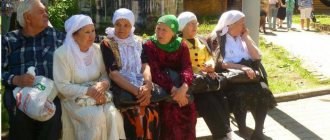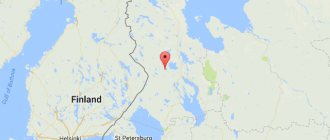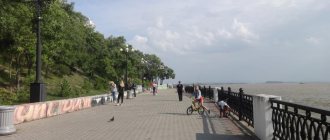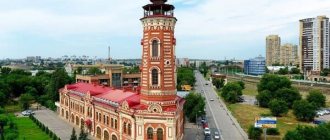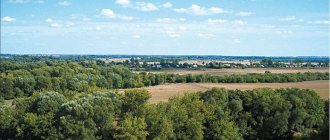Volgograd is a large city with a population of over a million, located on the right bank of the Volga, its length is more than 8 km. Today, in 2022, the current population of Volgograd is 1,008,998 people. It received its first name from the Tsar, based on the names of the two rivers Itil and Tsarina. The object was named Tsaritsyn. The second name of Volgograd from 1925 to 1961 was Stalingrad. It is located on the western side of the Volga River. Volgograd is also located together with such cities as Volzhsky, as well as Krasnoslobodsk.
They are located on the eastern side of the river and together form part of the Volgograd agglomeration. Trade crews passed through the reservoirs, conducting trade relations and developing logistics. Intellectual power and commercial activity are well developed here. The disadvantages of Volgograd include: the lack of jobs and the closure of all production enterprises and organizations.
Content
- 1 History 1.1 Tsaritsyn
- 1.2 Stalingrad 1.2.1 Battle of Stalingrad
- 12.1 Notes
Volgograd
(Volgograd region)
OKATO code:
18401
Founded:
1589
City since:
1589 City of regional subordination
Center:
Volgograd region
Urban areas, population as of 01/1/2021
| Voroshilovsky | 77.4 | Krasnoarmeisky | 159.9 | Traktorozavodsky | 134.5 |
| Dzerzhinsky | 180.3 | Krasnooktyabrsky | 142.7 | Central | 84.4 |
| Kirovsky | 97.8 | Soviet | 127.7 |
| The city was formerly called: | ||
| Tsaritsyn | 1925 | |
| Stalingrad | 1925 | 1961 |
| Telephone code (reference phone) | |
| 8442****** | 33-03-01 |
Deviation from Moscow time, hours:
0
Geographic latitude:
48°42′
Geographic longitude:
44°30′
Altitude above sea level, meters:
80 Sunrise and sunset times in the city of Volgograd
Story
See also: Chronology of Volgograd
Tsaritsyn
Coat of arms of Tsaritsyn (1857) Map of the city of Tsaritsyn (1909) City tram on Gogol Street in 1914 General Peter Wrangel in Tsaritsyn, October 15, 1919
Although the city may have originated in 1555, documentary evidence of Tsaritsyn
the confluence of the Tsaritsa[] and the Volga River dates back to 1589.[4]
Grigory Zasekin founded the fortress of Sary Su
(the local Tatar language name means "yellow water" or "yellow river") as part of the defense of the unstable southern border of the Russian Kingdom. The building stood slightly above the mouth of the Tsarina River on the right bank. It soon became the core of a trading settlement.
In 1607, the fortress garrison rebelled against the king's troops for six months. Vasily Shuisky. In 1608, the first stone church was built in the city, dedicated to John the Baptist. At the beginning of the 17th century, the garrison numbered between 350 and 400 people.
In 1670, Stepan Razin's troops captured the fortress; they left after a month. In 1708, the rebel Cossack Kondraty Bulavin (died in July 1708) occupied the fortress. In 1717, during the Kuban Pogrom[], raiders from Kuban under the command of the Crimean Tatar Bakhti Giray[] blocked the city and enslaved thousands of residents of the area. In August 1774, Emelyan Pugachev unsuccessfully tried to storm the city.
In 1691, Moscow established a customs post in Tsaritsyn. In 1708, Tsaritsyn was assigned to the Kazan province; in 1719 [ citation needed
] to Astrakhan province. According to the 1720 census, 408 people lived in the city. In 1773, the settlement was designated as a provincial and district town. Since 1779 it belonged to the Saratov governorship. In 1780, the city became part of the newly created Saratov province.
In the 19th century, Tsaritsyn became an important river port and trading center. The population grew rapidly, from less than 3,000 people in 1807 to approximately 84,000 in 1900. The railway arrived in the city in 1862. the theater opened in 1872, the first cinema in 1907. In 1913, the first tram line opened in Tsaritsyn, and the first electric lights were installed in the city center.
During the Russian Civil War 1917–1923. Tsaritsyn came under Soviet control in November 1917. In 1918, the White Army movement under Pyotr Krasnov, the Ataman of the Don Cossack Host, besieged Tsaritsyn. The Reds repelled three attacks from the Whites. However, in June 1919, the Armed Forces of the South of Russia, under the command of General Denikin, captured Tsaritsyn and held it until January 1920. Fighting from July 1918 to January 1920. Battle of Tsaritsyn.
Stalingrad
On April 10, 1925, the city was renamed Stalingrad in honor of Joseph Stalin, General Secretary of the Communist Party.[12][13] This was to officially recognize the city and Stalin's role in its defense against the Whites between 1918 and 1920.[14] In 1931, the German settlement-colony of Old Sarepta (founded in 1765) became the Stalingrad district. Renamed Krasnoarmeysky district
(or "Red Army District"), it was the largest district of the city.
The first university was opened in 1930. A year later, the Stalingrad Industrial Pedagogical Institute, now the Volgograd State Pedagogical University, was opened. Under Stalin, the city became a center of heavy industry and transshipment by rail and river.
The center of Stalingrad after liberation in 1943. Friedrich Paulus (left) and his assistants, Lieutenant General. Arthur Schmidt (center) and Colonel. Wilhelm Adam (right) after their surrender at Stalingrad. Presentation of the Stalingrad Sword at the Tehran Conference
Battle of Stalingrad
Main article: Battle of Stalingrad
During World War II, German and Axis forces attacked the city, and in 1942 it became the site of one of the decisive battles of the war. The Battle of Stalingrad was the deadliest battle in the history of the war (estimates range from 1,250,000[15] and 1,798,619[16]).
The battle began on August 23, 1942, and on the same day the city was heavily bombed from the air, leaving much of it in ruins. Martial law was declared in the city on July 14. By September the fighting had reached the city center. The fighting was of unprecedented intensity; The city's central station changed hands thirteen times, and Mamayev Kurgan (one of the city's highest points) was captured and recaptured eight times.
By early November, German forces controlled 90 percent of the city and had driven the Soviets into two narrow pockets, but they were unable to eliminate the last pockets of Soviet resistance before Soviet forces launched a huge counterattack on November 19. As a result, the Soviet encirclement of the German Sixth Army and other Axis units. On January 31, 1943, the commander of the 6th Army, Field Marshal Friedrich Paulus, surrendered, and by February 2, with the elimination of the German stragglers, the Battle of Stalingrad was over.
In 1945, the Soviet Union awarded Stalingrad the title of Hero City for its resilience. Great Britain's King George VI awarded the inhabitants of Stalingrad the “Sword of Stalingrad” jewels in recognition of their bravery.
A number of cities around the world (especially those that suffered similar destruction during the war) have established kinship relationships, friendships and sisterhoods of exile (see list below) in a spirit of solidarity or reconciliation. One of the first "sister city" projects was a project created during the Second World War between Stalingrad and Coventry into a united Kingdom; both suffered from aerial bombing.
Volgograd
Volga River in Volgograd Volgograd on the map of 1979.
Kazan Cathedral Construction of the Duma Region November 10, 1961 Nikita KhrushchevThe administration changed the city's name to Volgograd ("City of the Volga") as part of its de-Stalinization program after Stalin's death. He tried to reduce the "cult of personality." This action was and remains somewhat controversial because Stalingrad has such significance as a symbol of resistance during World War II.
During Konstantin Chernenko's short-term administration in 1984, proposals were put forward to revive the historical name of the city for this reason. There is strong local support for a return, but the Russian Government has not accepted such proposals.
On May 21, 2007, Roman Grebennikov of the Communist Party was elected mayor with 32.47% of the vote, plural. Grebennikov became the youngest mayor of a Russian city, a federal subject administrative center at that time.
In 2010, Russian monarchists and leaders of Orthodox organizations demanded that the city be returned to its original name, Tsaritsyn, but the authorities rejected their proposal.
On January 30, 2013, the Volgograd City Council passed measures to use the title "Hero City of Stalingrad" in city proclamations on nine specific dates annually.[17][18][19] On the following days, the title “Hero City of Stalingrad” can be officially used in festive events:
- February 2 (end of the Battle of Stalingrad),
- February 23 (Defender of the Fatherland Day),
- May 9 (Victory Day),
- June 22 (beginning of Operation Barbarossa),
- August 23 (beginning of the Battle of Stalingrad),
- September 2 (Victory Day over Japan),
- November 19 (beginning of Operation Uranus),
- December 9 (Heroes of the Fatherland Day)[17]
In addition, 50,000 people signed a petition asking Vladimir Putin to permanently change the name of the city to Stalingrad.[18] President Putin responded that such a move should be preceded by a local referendum, and that Russian authorities would study how to conduct such a referendum.[20]
Reviews from tourists
Inspiring and detailed - these are the reviews from tourists about Volgograd. Travelers who have already been to the city share their walking routes and impressions, and there are always a lot of them here, and discover interesting but little-known corners of the guidebooks. And although winter is not the most popular time to travel to Volgograd, it has advantages for those who appreciate the absence of crowds or cannot stand the heat that reigns in the city in the summer.
Users of the site about Volgograd: Svetlana Appolonova shared a solid story about Mamayev Kurgan “And one warrior in the field, if he is tailored in Russian,” and Victor shared the publication “Bright Lights of Volgograd” about the city on the eve of the New Year.
All tourist reviews about Volgograd on Tourist. RU
Exposition of the Museum “Memory” Photo: © Alexey Panin
Transport
Volgograd is a large railway junction served by the Volga Railway. Train connections from Volgograd Station include Moscow; Saratov; Astrakhan; then Donbass region of Ukraine; then the Caucasus and Siberia. It stands at the eastern end of the Volga–Don Canal, opened in 1952 to link the two great rivers of southern Russia. European route E40, the longest European route connecting Calais in France with Ridder in Kazakhstan, passes through Volgograd. The M6 Highway between Moscow and the Caspian Sea also passes through the city. The Volgograd Bridge, under construction since 1995, was opened in October 2009.[23] The city river station is the center of local passenger transportation along the Volga.
Volgograd International Airport provides air connections with major Russian cities, as well as Antalya, Yerevan and Aktau.
Volgograd's public transport system includes a high-speed tram service known as the Volgograd Metrotram. Local public transport is served by buses, trolleybuses and trams.
The Volga River still remains a very important communication channel.
Volgograd is home to one of the few floating churches in the world: the floating church of St. Vladimir of Volgograd.[ citation needed
]
- Trolza-5275 small trolleybus
- Volgograd International Airport
- Volgograd metrotram
Environmental problems of the river
The ecology of the river needs protection. The influence of man on her is great and detrimental. Unfortunately, about thirty percent of all garbage ends up in this great river, and the environmental issue is quite acute here. Many species of various flora and fauna are dying.
Some fish species undergo severe mutation, and algae grow too rapidly. Various steps are being taken to preserve the environment: for example, in 2008, UNESCO organized the “Living Volga” project, and the “Great Rivers” forum was also held. The future of the river is in the hands of generations who are not indifferent to this problem.
Climate
Volgograd has a hot summer humid continental climate (Köppen: DFA
).[24] Despite its location further north, the city is slightly warmer than Minneapolis, albeit not significantly (both summer and winter, but the transition seasons are almost identical), while at the same time, despite being "wet" taxed, it is drier than the greater part of climate group D due to proximity to the Middle East and Central Asia.[25]
| Climate data for Volgograd | |||||||||||||
| Month | Jan | Feb | Mar | Apr | May | Jun | Jul | Aug | Sep | October | But I | December | Year |
| Record high °C (°F) | 12.3 (54.1) | 15.8 (60.4) | 20.5 (68.9) | 29.2 (84.6) | 37.2 (99.0) | 39.4 (102.9) | 41.8 (107.2) | 42.6 (108.7) | 37.8 (100.0) | 31.0 (87.8) | 21.0 (69.8) | 12.3 (54.1) | 42.6 (108.7) |
| Average high °C (°F) | −3.3 (26.1) | −3.1 (26.4) | 3.6 (38.5) | 14.9 (58.8) | 21.9 (71.4) | 27.0 (80.6) | 29.6 (85.3) | 28.6 (83.5) | 21.6 (70.9) | 13.0 (55.4) | 3.6 (38.5) | −1.9 (28.6) | 13.0 (55.4) |
| Daily average °C (°F) | −5.7 (21.7) | −5.9 (21.4) | .1 (32.2) | 9.9 (49.8) | 16.7 (62.1) | 21.6 (70.9) | 24.2 (75.6) | 23.0 (73.4) | 16.4 (61.5) | 8.8 (47.8) | .8 (33.4) | −4.2 (24.4) | 8.8 (47.8) |
| Average low °C (°F) | −9.0 (15.8) | −9.7 (14.5) | −3.9 (25.0) | 4.2 (39.6) | 10.1 (50.2) | 15.1 (59.2) | 17.5 (63.5) | 16.2 (61.2) | 10.4 (50.7) | 4.1 (39.4) | −2.4 (27.7) | −7.3 (18.9) | 3.8 (38.8) |
| Record low °C (°F) | −33.0 (−27.4) | −32.5 (−26.5) | −25.8 (−14.4) | −12.8 (9.0) | −1.1 (30.0) | 2.0 (35.6) | 7.4 (45.3) | 4.5 (40.1) | −1.0 (30.2) | −12.2 (10.0) | −25.8 (−14.4) | −27.8 (−18.0) | −33.0 (−27.4) |
| Average precipitation mm (inches) | 38 (1.5) | 30 (1.2) | 28 (1.1) | 28 (1.1) | 39 (1.5) | 41 (1.6) | 35 (1.4) | 30 (1.2) | 29 (1.1) | 29 (1.1) | 34 (1.3) | 45 (1.8) | 406 (16.0) |
| Average snowfall, cm (inches) | 11 (4.3) | 18 (7.1) | 10 (3.9) | 1 (0.4) | track | 0 (0) | 0 (0) | 0 (0) | 0.1 (0.0) | 1 (0.4) | 1 (0.4) | 6 (2.4) | 48.1 (18.9) |
| Average rainy days | 9 | 7 | 8 | 12 | 12 | 12 | 11 | 8 | 10 | 11 | 12 | 11 | 123 |
| Average snow days | 20 | 18 | 11 | 2 | 0.03 | 0 | 0 | 0 | 0.1 | 1 | 9 | 18 | 79 |
| Average relative humidity (%) | 88 | 86 | 81 | 64 | 57 | 56 | 53 | 51 | 61 | 73 | 86 | 89 | 70 |
| Average monthly sunshine | 66.1 | 96.9 | 138.4 | 204.2 | 290.8 | 308.4 | 329.3 | 300.2 | 228.9 | 155.8 | 63.6 | 42.5 | 2,225.1 |
| Source 1: Pogoda.ru.net[26] | |||||||||||||
| Source 2: Weather Database (sun only)[27] | |||||||||||||
Culture
Church of All Saints Volgograd Synagogue (1911), Port Said Street
Memorial complex dedicated to the Battle of Stalingrad, with a huge allegorical sculpture. The Motherland is calling
, erected on Mamayev Kurgan, a hill on which some of the fiercest fighting took place during the battle.
The Panorama Museum
located on the Volga contains artifacts from the Second World War. These include a panoramic picture of the battlefield from the location of the monument on Mamayev Kurgan. A rifle of the famous sniper Vasily Zaitsev is also on display.
The Museum of Musical Instruments is a branch of the Volgograd Regional Museum of Local Lore.
Where to go with children in winter
If you come to Volgograd with children, your travel program will include classic children's places and educational sites where young tourists will not get bored.
In the Central Park of Volgograd in winter there is an ice skating rink and slides from which you can ride a cheesecake. The same entertainment and a large play town in the shape of a ship are offered by the Razdolye park . Right on its territory there is also a multimedia park “Russia - My History” , where you can go with schoolchildren whose curriculum already includes the history of Russia. In addition, with them you can visit all the places telling about the Battle of Stalingrad 1942-1943.
Ice skating rink in Razdolye Park Photo: © Official page of Razdolye Park on Instagram
Unusual museums will definitely capture children's attention. Not far from Razdolye there is the Einstein Museum , which will show the most spectacular processes of physics and chemistry. The chocolate museum “Shokoladushka” will tell you about cocoa and chocolate, offer a lot of creative tasks and, of course, a tasting of the delicacy. At the Museum of Russian Fairy Tales , which is located across the Volga in one of the surrounding villages, children can take a tour of life-size fairy tale settings. Small performances and competitions are expertly performed by fairy tale characters.
Famous children's works come to life at the Volgograd Puppet Theater . Theatrical performances take place in a small cozy hall on the street. Lenin. And the Volgograd Youth Theater will delight you with performances on the big stage. For more than half a century since his second birth, he has occupied a building with bright mosaics on the street. Workers' and Peasants'.
The Volgograd Planetarium will occupy the minds of young researchers with stars, constellations, comets and other wonders of space. Lectures with film screenings are held under the dome of a beautiful building and are available to visitors from 7–14 years old. of the Volgograd Oceanarium will be captivated by the beauty of the sea depths . In addition to hundreds of fish, it is home to penguins, otters and several species of reptiles. The aquarium is small, occupies part of the Marmelad shopping center, but is quite interesting for small spectators. There will also be a variety of attractions and the Activizon sports park .
Entertainment centers, quests, laser tag and other places where you can relax with children and not only in winter, also in a separate material:
Volgograd for children
Education
Higher education institutions include:
- Volgograd State University
- Volgograd State Technical University (formerly Volgograd Polytechnic University)[28]
- Volgograd State Agrarian University
- Volgograd State Medical University[29]
- Volgograd State University of Architecture and Civil Engineering
- Volgograd Industrial Academy
- Volgograd Academy of Business Administration[30]
- Volgograd State Pedagogical University
Sports
Aerial view of Volgograd Arena in 2022
| Club | Sport | Based | Current league | League Level | Stadium |
| Rotor Volgograd | Football | 1929 | Russian professional football league | 2nd | central Stadium |
| Olympia Volgograd | Football | 1989 | Volgograd Region Football Championship | 5th | Olympia Stadium |
| Caustic Volgograd | Handball | 1929 | Handball Super League | 1st | Sports complex Dynamo |
| Dynamo Volgograd | Handball | 1929 | Women's Handball Super League | 1st | Sports complex Dynamo |
| Red October Volgograd | Basketball | 2012 | VTB United League | 2nd | Palace of Sports of Trade Unions |
| Spartak Volgograd | Water polo | 1994 | Russian Water Polo Championship | 1st | CVVS |
Volgograd hosted four championship matches. FIFA World Cup in 2022. A new modern stadium, Volgograd Arena, was built for the occasion on the banks of the Volga as the venue. The stadium seats 45,000 people, including a press box, VIP box and accessible seating.
Ethnic composition
Volgograd is inhabited by many nationalities. There are more than 120 nations, whose cultures differ sharply from each other; no conflict situations among citizens have been caused on the territory of Volgograd. The solid formation of the mentality was unshakably reflected in the friendliness of the city residents. Ethnic composition: Russians 90%, second place is occupied by Kazakhs, third – Ukrainians, Armenians, Tatars, Dargins. Volgograd is inhabited by Azerbaijanis.
- Mordovians, which include Erzya and Moksha.
- Kazakhs.
- Chuvash.
- Dargins, which include the Kaitags and Kubachis.
- Udmurts.
- Jews.
- Altaians.
- Tajiks.
- Gypsies.
- Mari.
- Ossetians, including Digorons and Irons.
- Belarusians.
- Bashkirs.
- Kabardians.
The above nationalities account for no more than 0.5% of the total number of Russians.
Famous people
Main article: List of people from Volgograd
- Vasily Zaitsev, Soviet sniper and Hero of the Soviet Union.
- Nikolay Davydenko, tennis player
- Sasha Filippov, spy
- Oleg Grebnev, handball player
- Ekaterina Grigorieva, sprinter
- Larisa Ilchenko, long-distance swimmer
- Elena Isinbaeva, pole vaulter
- Lev Ivanov, association football manager
- Yuri Kalitvintsev, football manager of the association
- Elem Klimov, film director
- Egor Kulechev professional basketball player
- Alexey Kravtsov, lawyer
- Vladimir Kryuchkov, statesman
- Tatiana Lebedeva, jumper
- Maxim Marinin, figure skater
- Maxim Opalev, sprint canoeist
- Alexandra Pakhmutova, composer
- Denis Pankratov, Olympic swimmer
- Evgeni Plushenko, Olympic figure skater
- Evgeny Sadovy, Olympic swimmer
- Natalya Shipilova, handball player
- Elena Slesarenko, high jumper
- Leonid Slutsky, football coach
- Yulia Sotnikova, Athlete 400m
- Julia McLean Townsend, classical opera singer
- Igor Vasiliev, handball player
- Oleg Veretennikov, association footballer
- Natalya Vikhlyantseva, tennis player
International relationships
See also: List of sister cities and sister cities in Russia
Volgograd double from:[31]
- Coventry, United Kingdom (1944)
- Ostrava, Czech Republic (1948)
- Kemi, Finland (1953)
- Vassal, Belgium (1959)
- Dijon, France (1959)
- Port Said, Egypt (1962)
- Chennai, India (1967)
- Hiroshima, Japan (1972)
- Cologne, Germany (1988)
- Chemnitz, Germany (1988)
- Cleveland, USA (1990)
- Jilin, China (1994)
- Krusevac, Serbia (1999)
- Ruse, Bulgaria (2001)
- Izmir, Türkiye (2011)
- Chengdu, China (2011)
- Olevano Romano, Italy (2014)
- Ortona, Italy (2014)
- Yerevan, Armenia (2015)
- Several communities in France and Italy have streets or avenues named after Stalingrad, hence Stalingrad Square
in Paris and the eponymous Paris metro station Stalingrad.
Recommendations
Notes
- ^ a b c
Charter of Volgograd, Preamble - ^ a b c d f
Law No. 139-OD - Official website of Volgograd. The competition to create the anthem of Volgograd will be held again (in Russian)
- ^ a b Encyclopedia of Russian Cities
. Moscow: Great Russian Encyclopedia. 2003. pp. 81–83. ISBN 5-7107-7399-9. - ^ a b
Charter of Volgograd, article 22 - Federal State Statistics Service of Russia (2011). “All-Russian Population Census 2010. Volume 1" [All-Russian Population Census 2010, vol. 1]. All-Russian Population Census 2010 [All-Russian Population Census 2010]
(in Russian). Federal State Statistics Service. - "26. The size of the permanent population of the Russian Federation by municipalities as of January 1, 2022.” Federal State Statistics Service. Retrieved January 23, 2022.
- ^ a b c
Law No. 1031-OD - "On the calculation of time." Official Internet portal of legal information
(in Russian). June 3, 2011. Retrieved January 19, 2022. - Post office. Information and computing center of OASU RPO. ( Post office
).
Search for postal facilities ( Search for postal facilities
) (in Russian) - "RUSSIA: Southern Federal District: Southern Federal District." City Population.de. August 4, 2022. Retrieved October 18, 2020.
- Lutz-Aury, Lyudmila (2012). "Auf Stalin, Sieg Und Vaterland!": Politisierung Der Kollektiven Erinnerung an Den Zweiten Weltkrieg in Russia
(in German). Springer-Verlag. p. 189. ISBN 978-3658008215. - McCauley, Martin (2013). Stalin and Stalinism
(3rd ed.). Rutledge. ISBN 978-1317863687. April 10, 1925: Tsaritsyn was renamed Stalingrad. - Brewer's Dictionary of Twentieth Century Phrases and Fables
- Grant, R. G. (2005). The Battle: A Visual Journey Through 5,000 Years of Battle
. Dorling Kindersley. ISBN 0-7566-1360-4. - Wagner, Margaret; and others. (2007). The Library of Congress Companion to World War II
. Simon and Schuster. ISBN 978-0-7432-5219-5. - ^ a b
Decision No. 72/2149 - ^ a b
"Russia revives the name of the city of Stalingrad."
Daily Telegraph
. January 31, 2013. Retrieved February 7, 2013. - “The name of Stalingrad will be revived for the anniversaries.” BBC News Online
. February 1, 2013. Retrieved February 7, 2013. - “Putin says the Russian city of Volgograd could become Stalingrad again.” TASS
. - “Volgograd surrendered to elections.” www.gazeta.ru
. 2012. - Europa Publications (26 February 2004). "Southern Federal District". Territories of the Russian Federation 2004
. Taylor and Francis Group. paragraph 174. ISBN 9781857432480. Received March 4, 2022. The administrative center of the region is located in Volgograd. - Ivanov opened the largest bridge in Europe in Volgograd (in Russian). News. Retrieved February 9, 2011.
- "Volgograd, Russian Köppen climate classification (meteorological base)." Weather database
. Retrieved November 13, 2022. - "Average weather in Volgograd, Russia, all year round - Weather Spark." weatherspark.com
. Retrieved May 23, 2022. - "Pogoda.ru.net" (in Russian). Retrieved July 7, 2016.
- "Weather database: historical weather for Volgograd, Russia." Weather database. Retrieved November 17, 2012.
- "Volgograd State Technical University - Home". Vstu.ru August 21, 2011. Archived from the original on September 3, 2011. Retrieved September 15, 2011.
- Russia. "Volgograd State Medical University (Volgograd State Medical University)". Volgmed.ru. Retrieved September 15, 2011.
- "The Internet Archive's Wayback Machine." June 27, 2007. Archived from the original on June 27, 2007. Retrieved September 15, 2011.
- "Twin Cities". volgadmin.ru
(in Russian). Volgograd. Retrieved February 1, 2022.
Sources
- Volgograd City Council of People's Deputies. Resolution No. 20 / 362 of June 29, 2005 “Charter of the Hero City of Volgograd,” as amended. Decision No. 32 / 1000 of July 15, 2015 “On introducing amendments and additions to the Charter of the Hero City of Volgograd.” Entered into force on March 10, 2006 (except for certain provisions). Published: "Volgogradskaya Gazeta", No. 7, March 9, 2006 (Volgograd City Council of People's Deputies. Resolution No. 20 / 362 of June 29, 2005. Charter of the Hero City of Volgograd
as amended by Decision of July 15, 2015 No. 32/1000.
On introducing amendments and additions to the Charter of the Hero City of Volgograd
... Valid from March 10, 2006 (with the exception of some points). - Volgograd Regional Duma. Law No. 139-OD of October 7, 1997 “On the administrative-territorial structure of the Volgograd region”, as amended by Law No. 107-OD of July 10, 2015 “On amendments to certain legislative acts of the Volgograd region in connection with bringing them in accordance with the Charter of the Volgograd Region." Came into force on the date of official publication. Published: “Volgogradskaya Pravda”, No. 207, November 1, 1997 (Volgograd Regional Duma. Law No. 139-OD of October 7, 1997 On the administrative-territorial structure of the Volgograd Region
As amended by Law No. 107-OD dated July 10, 2015.
On amendments to various legislative acts of the Volgograd region to ensure compliance with the Charter of the Volgograd region
... Valid from the date of official publication.). - Volgograd Regional Duma. Law No. 1031-OD of March 21, 2005 “On granting the hero city of Volgograd the status of an urban district and establishing its boundaries,” as amended. Law No. 2013-OD of March 22, 2010 “On amendments to the Law of the Volgograd Region of March 21, 2005 No. 1031-OD “On granting the hero city of Volgograd the status of an urban district and establishing its boundaries.” Came into force on the date of official publication (March 22, 2005). Published: “Volgogradskaya Pravda”, No. 49, March 22, 2005 (Volgograd Regional Duma. Law No. 1031-OD of March 21, 2005 On assigning the status of an urban district to the hero city of Volgograd and on establishing its borders
As amended by the Law dated 22 March 2010 No. 2013-OD.
On amendments to the Law of the Volgograd Region No. 1031-OD dated March 21, 2005 “On assigning the status of an urban district to the hero city of Volgograd and on establishing its boundaries.”
Valid from the date of official publication (22 March 2005). - Volgograd City Duma. Decision No. 72 / 2149 of January 30, 2013 “On the use of the name “hero city of Stalingrad”,” as amended. Decision No. 9 / 200 of December 23, 2013 “On amendments to paragraph 1 of the Procedure for using the name “hero city of Stalingrad”, established by the Decision of the Volgograd City Duma of January 30, 2013 No. 72 / 2149” On the use of the name “hero city of Stalingrad” "" : “City news. Tsaritsyn - Stalingrad - Volgograd ", # 10, February 2, 2013 (Volgograd City Duma. Decision No. 72/2149 of January 30, 2013. On the use of the name "Hero City of Stalingrad"
As amended by decision No. 9/200 of December 23 2013
On amendments to paragraph 1 of the Procedure for using the name “Hero City of Stalingrad”, adopted by decision of the Volgograd City Duma No. 72/2149 of January 30, 2013 “On the use of the name “Hero City of Stalingrad”
. Valid from the date of adoption.)

